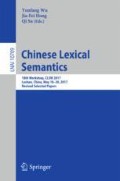Abstract
A large number of morpheme-inverted words are unique elements in Chinese vocabulary, which is an important lexical phenomenon occurred in the history of the development and evolution of Chinese vocabulary. As a corpus driven study, this paper discusses a pair of morpheme-inverted words dòuzhēng ( ) and zhēngdòu (
) and zhēngdòu ( ) from microscopic perspective. Based on the statis-tics and analysis, this paper explores the origin, occurrence time, evolution pro-cess, service conditions and the reasons of semantic changes of dòuzhēng (
) from microscopic perspective. Based on the statis-tics and analysis, this paper explores the origin, occurrence time, evolution pro-cess, service conditions and the reasons of semantic changes of dòuzhēng ( ) and zhēngdòu (
) and zhēngdòu ( ). And this study aims at providing some reference for the study of morpheme-inverted words from microscopic perspective.
). And this study aims at providing some reference for the study of morpheme-inverted words from microscopic perspective.
Access this chapter
Tax calculation will be finalised at checkout
Purchases are for personal use only
Preview
Unable to display preview. Download preview PDF.
References
Cao Tingyu: A Study on the Same–Morpheme and Contrary–Order Synonym of Modem Chinese. Jinan Journal (Philosophy & Social Science Edition) (05), 57–64 (2010).
Cen Shifu: “Gentle” or “Ease”. Chinese Knowledge, (1956).
Ding Mianzai: Ding Mianzai: The Structure and Meaning of the Same Words.Academic Monthly (02), (1957).Academic Monthly (02), (1957).
Han Chenqi: The Disyllabic Words Inversing the Word Order in the Historical Records. Studies of the Chinese Language (03), (1983).
Lin Yan: Reverse order with the prime word “calculation–calculating” research. Central China Normal University (2011).
Tan Ruwei: Tan Ruwei: Four Aspects of the morpheme-inversed words. A New Study of Lexical Studies. Language Press, Beijing (1995).
Wang Sen, Wang Yi: Disyllable Words of Different Arrangement in Jin Ping Mei Ci Hua. Journal of Lanzhou University (06), 125–135 (2000).
Xun Endong, Rao Gaoqi, Xiao xiaoyue, Zang Jiaojiao: The construction of the BCC Cor-pus in the age of Big Data. Corpus Linguistics (1), (2016).
Zhang Dexin: Talk about the Inverted Words. Chinese Language Learning, (06), 18–22 (1995).
Zhang Qiyun: A Unified Study of Chinese Words in Modern Chinese. Studies in Language and Linguistics (01), 72–82 (2002).
Zhang Wei: Studies on morpheme-inversed words in dialects. Tangdu Journal, (03), 117–120 (2007).
Zhang Wei: A Study on the Morpheme-inversed Words of Middle Chinese. Fudan University (2005).
Zhang Yongmian: The Disyllabic Words with Inversed Characters in Modern Chinese, Studies of the Chinese Language (03), (1980).
Zhang Zhiyi, Zhang Qingyun: Lexical Semantics. The Commercial Press, Beijing (1992).
Zheng Dian: The Disyllabic Words in Ancient Chinese. Studies of the Chinese Language (06), (1964).
Modern Chinese Dictionary. The Commercial Press, Beijing (2005).
Center for Chinese Linguistics PKU, http://ccl.pku.edu.cn:8080/ccl_corpus/, 2017/6/30
Author information
Authors and Affiliations
Corresponding author
Editor information
Editors and Affiliations
Rights and permissions
Copyright information
© 2018 Springer International Publishing AG
About this paper
Cite this paper
Wensi, L. (2018). Competition and Differentiation of a Pair of Morpheme-inverted Words in Mandarin Chinese: Dòuzhēng and Zhēngdòu. In: Wu, Y., Hong, JF., Su, Q. (eds) Chinese Lexical Semantics. CLSW 2017. Lecture Notes in Computer Science(), vol 10709. Springer, Cham. https://doi.org/10.1007/978-3-319-73573-3_19
Download citation
DOI: https://doi.org/10.1007/978-3-319-73573-3_19
Published:
Publisher Name: Springer, Cham
Print ISBN: 978-3-319-73572-6
Online ISBN: 978-3-319-73573-3
eBook Packages: Computer ScienceComputer Science (R0)

